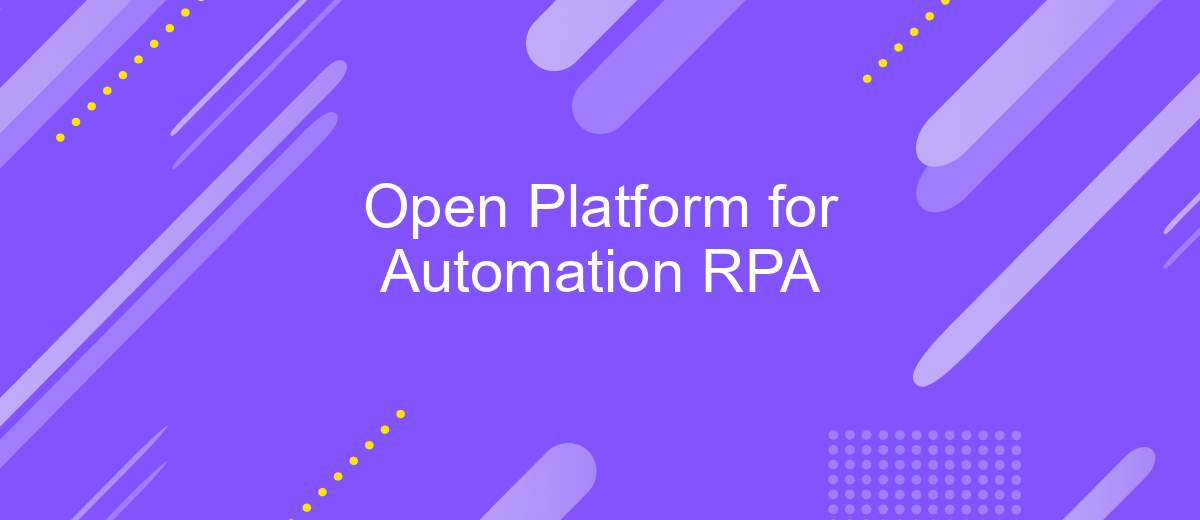Open Platform for Automation RPA
Open Platform for Automation (RPA) is revolutionizing the way businesses operate by streamlining processes and enhancing efficiency. This cutting-edge technology allows organizations to automate repetitive tasks, freeing up valuable human resources for more strategic activities. By integrating RPA, companies can significantly reduce operational costs and improve accuracy, leading to increased productivity and competitiveness in the market. Explore how RPA is transforming industries and driving innovation.
Introduction
The rapid evolution of digital technologies has ushered in a new era of automation, fundamentally transforming how businesses operate. Open Platform for Automation RPA (Robotic Process Automation) emerges as a pivotal solution, enabling organizations to streamline processes, enhance efficiency, and reduce operational costs. By leveraging open platforms, businesses can integrate RPA more seamlessly into their existing systems, fostering innovation and adaptability.
- Seamless integration with existing IT infrastructure
- Enhanced flexibility and scalability
- Cost-effective automation solutions
- Improved operational efficiency and accuracy
- Facilitation of digital transformation initiatives
As industries increasingly recognize the value of automation, the demand for open platforms in RPA continues to grow. These platforms offer a versatile foundation that supports diverse business needs, from simple task automation to complex process orchestration. By adopting an open platform approach, companies can harness the full potential of RPA, driving sustainable growth and maintaining competitive advantage in an ever-evolving marketplace.
Key Features and Benefits

Open Platform for Automation RPA offers a comprehensive suite of features designed to streamline business processes and enhance productivity. Its user-friendly interface allows for easy deployment and management of automation workflows, reducing the need for extensive IT involvement. The platform supports a wide range of integrations, enabling seamless communication between various business applications. With its robust security measures, organizations can ensure data integrity and compliance, making it an ideal choice for industries that handle sensitive information.
One of the standout benefits of this platform is its scalability, allowing businesses to start small and expand their automation capabilities as needed. The inclusion of tools like ApiX-Drive facilitates effortless integration setup, connecting disparate systems without the need for custom coding. Additionally, the platform's analytics feature provides valuable insights into process performance, helping businesses identify areas for improvement. By leveraging these capabilities, organizations can achieve significant cost savings and operational efficiencies, ultimately driving innovation and growth.
Use Cases and Implementation

Open Platform for Automation (OPA) RPA provides versatile solutions across various industries, enhancing efficiency and reducing manual workload. Its adaptability allows businesses to streamline processes, improve accuracy, and save time. By integrating OPA RPA, companies can automate repetitive tasks, allowing employees to focus on more strategic activities.
- In finance, OPA RPA can automate invoice processing, reducing errors and speeding up payment cycles.
- In healthcare, it assists in patient data management, ensuring accurate records and facilitating better patient care.
- In retail, it enhances inventory management by automating stock level monitoring and replenishment processes.
- In customer service, it can automate responses to common inquiries, improving response times and customer satisfaction.
Implementing OPA RPA involves a strategic approach, beginning with identifying processes that benefit most from automation. Businesses should conduct a thorough analysis of current workflows to pinpoint inefficiencies. Once identified, OPA RPA tools can be tailored to fit specific needs, ensuring seamless integration with existing systems. Training and support are crucial to maximize the benefits of automation, enabling employees to adapt to new workflows effectively.
Challenges and Limitations

Implementing an Open Platform for Automation RPA presents several challenges that organizations must navigate. One of the primary issues is the integration of diverse systems. As companies use a myriad of software solutions, ensuring seamless interoperability can be complex and time-consuming. Additionally, maintaining data security and privacy is a significant concern, as automation processes often handle sensitive information.
Another limitation is the scalability of the platform. As businesses grow, their automation needs evolve, requiring the platform to adapt without compromising performance. This adaptability demands robust infrastructure and continuous updates to accommodate new technologies and processes.
- Complex integration with existing systems
- Ensuring data security and privacy
- Scalability and adaptability challenges
- Continuous need for updates and maintenance
Moreover, the initial cost of implementing an Open Platform for Automation RPA can be prohibitive for smaller enterprises. They may struggle with the financial and resource investment required for successful deployment. To overcome these challenges, organizations must carefully plan their automation strategy, considering both short-term and long-term goals, while ensuring they have the necessary support and expertise.
Conclusion
The exploration of Open Platform for Automation RPA underscores its transformative potential in streamlining business processes and enhancing operational efficiency. By leveraging an open platform, organizations can customize and scale their automation strategies, ensuring seamless integration with existing systems. This flexibility not only reduces manual workloads but also accelerates digital transformation, enabling businesses to remain competitive in a rapidly evolving market.
Furthermore, the integration of services like ApiX-Drive can significantly enhance the capabilities of RPA platforms. By facilitating smooth and efficient data transfer between disparate systems, ApiX-Drive empowers organizations to automate complex workflows with ease. This synergy between open platforms and integration services creates a robust framework for innovation, allowing businesses to optimize resources and focus on strategic initiatives. As the landscape of automation continues to evolve, embracing open platforms and versatile integration solutions will be crucial for organizations aiming to achieve sustainable growth and operational excellence.
FAQ
What is RPA and how does it work?
What are the benefits of using an open platform for RPA?
How can businesses integrate RPA with their existing systems?
Is RPA suitable for small businesses, or is it only for large enterprises?
What are some common challenges faced when implementing RPA?
Time is the most valuable resource in today's business realities. By eliminating the routine from work processes, you will get more opportunities to implement the most daring plans and ideas. Choose – you can continue to waste time, money and nerves on inefficient solutions, or you can use ApiX-Drive, automating work processes and achieving results with minimal investment of money, effort and human resources.

